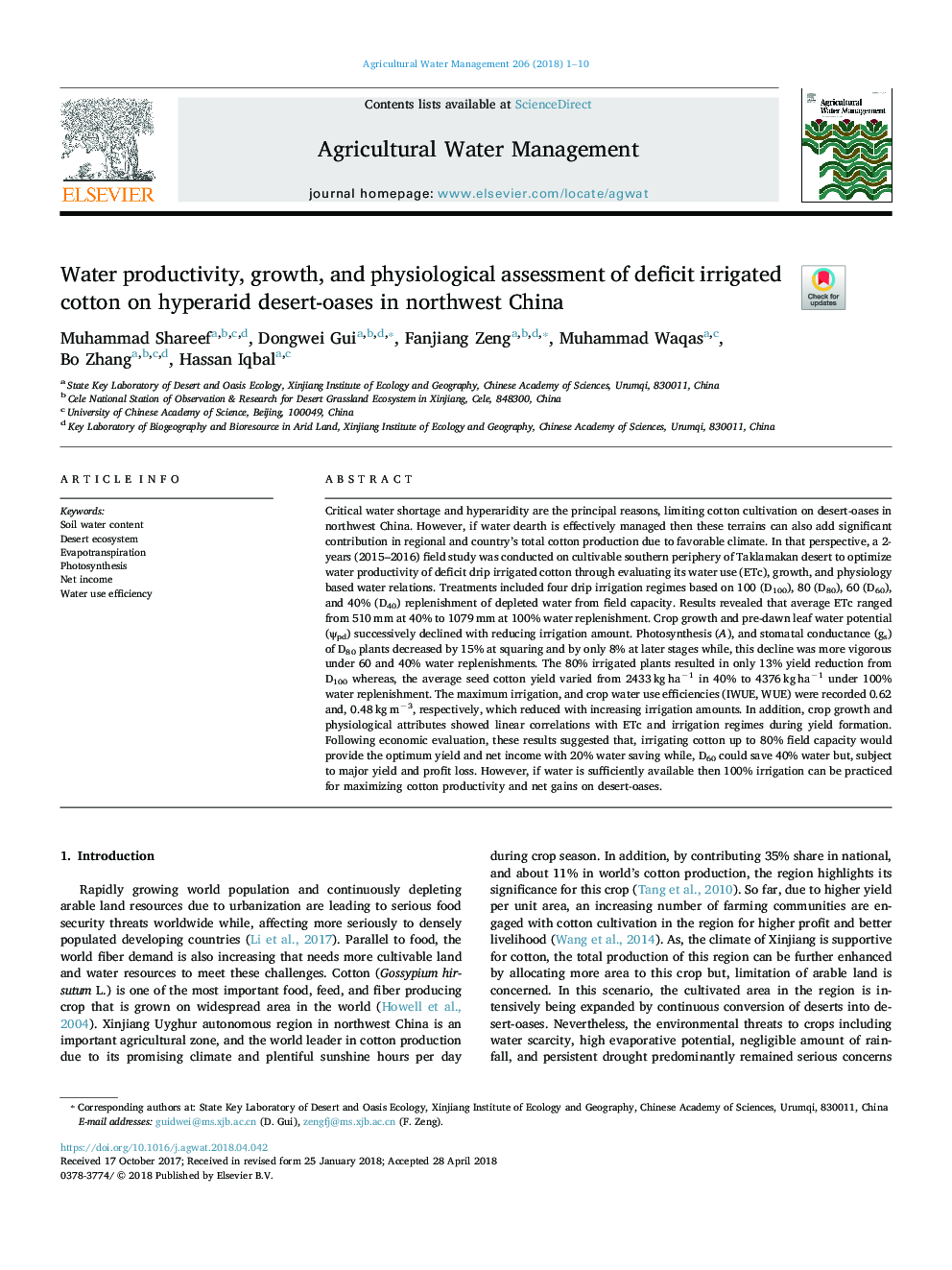| کد مقاله | کد نشریه | سال انتشار | مقاله انگلیسی | نسخه تمام متن |
|---|---|---|---|---|
| 8872833 | 1622874 | 2018 | 10 صفحه PDF | دانلود رایگان |
عنوان انگلیسی مقاله ISI
Water productivity, growth, and physiological assessment of deficit irrigated cotton on hyperarid desert-oases in northwest China
ترجمه فارسی عنوان
بهره وری آب، رشد و ارزیابی فیزیولوژیکی کسری آبیاری پنبه در اراضی بیابانی در شمال غرب چین
دانلود مقاله + سفارش ترجمه
دانلود مقاله ISI انگلیسی
رایگان برای ایرانیان
کلمات کلیدی
محتوای آب خاک، اکوسیستم کویر تبخیر تعرق، فتوسنتز، درآمد خالص، بهره وری استفاده از آب،
موضوعات مرتبط
علوم زیستی و بیوفناوری
علوم کشاورزی و بیولوژیک
علوم زراعت و اصلاح نباتات
چکیده انگلیسی
Critical water shortage and hyperaridity are the principal reasons, limiting cotton cultivation on desert-oases in northwest China. However, if water dearth is effectively managed then these terrains can also add significant contribution in regional and country's total cotton production due to favorable climate. In that perspective, a 2-years (2015-2016) field study was conducted on cultivable southern periphery of Taklamakan desert to optimize water productivity of deficit drip irrigated cotton through evaluating its water use (ETc), growth, and physiology based water relations. Treatments included four drip irrigation regimes based on 100 (D100), 80 (D80), 60 (D60), and 40% (D40) replenishment of depleted water from field capacity. Results revealed that average ETc ranged from 510â¯mm at 40% to 1079â¯mm at 100% water replenishment. Crop growth and pre-dawn leaf water potential (Ïpd) successively declined with reducing irrigation amount. Photosynthesis (A), and stomatal conductance (gs) of D80 plants decreased by 15% at squaring and by only 8% at later stages while, this decline was more vigorous under 60 and 40% water replenishments. The 80% irrigated plants resulted in only 13% yield reduction from D100 whereas, the average seed cotton yield varied from 2433â¯kgâ¯haâ1 in 40% to 4376â¯kgâ¯haâ1 under 100% water replenishment. The maximum irrigation, and crop water use efficiencies (IWUE, WUE) were recorded 0.62 and, 0.48â¯kgâ¯mâ3, respectively, which reduced with increasing irrigation amounts. In addition, crop growth and physiological attributes showed linear correlations with ETc and irrigation regimes during yield formation. Following economic evaluation, these results suggested that, irrigating cotton up to 80% field capacity would provide the optimum yield and net income with 20% water saving while, D60 could save 40% water but, subject to major yield and profit loss. However, if water is sufficiently available then 100% irrigation can be practiced for maximizing cotton productivity and net gains on desert-oases.
ناشر
Database: Elsevier - ScienceDirect (ساینس دایرکت)
Journal: Agricultural Water Management - Volume 206, 30 July 2018, Pages 1-10
Journal: Agricultural Water Management - Volume 206, 30 July 2018, Pages 1-10
نویسندگان
Muhammad Shareef, Dongwei Gui, Fanjiang Zeng, Muhammad Waqas, Bo Zhang, Hassan Iqbal,
